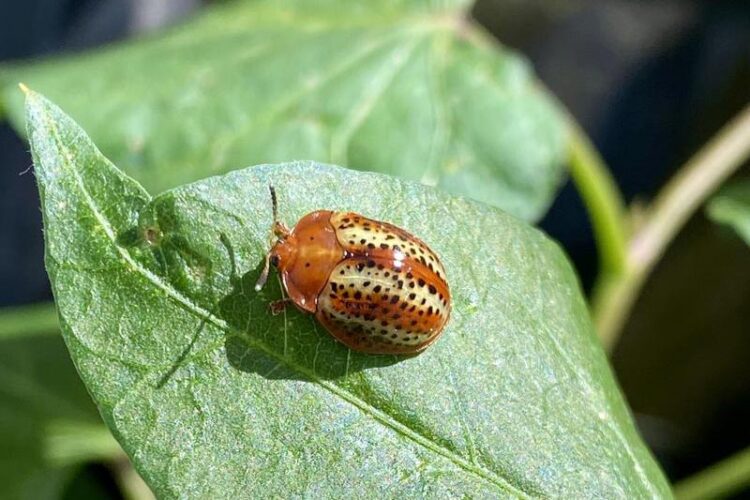Microbes protect a leaf beetle – but for a price

Leaf Beetle
Credit: Max Planck Institute for Biology Tübingen
Insects are known to rely on microbial protection during immobile developmental stages, such as eggs. But despite the susceptibility of pupae to antagonistic challenges, the role of microbes in ensuring defense during an insect’s metamorphosis remained an open question. Scientists from Germany and Panama have now discovered a novel defensive partnership between a fungus and a leaf beetle. The microbe provides a protective layer around the beetle´s pupae and thus prevents predation. In exchange, the beetle disperses the fungus to its host plant, expanding its range. Now published in Current Biology, the researchers present the results of their study.
Antagonistic interactions are widespread in nature, spurring the evolution of protective traits. In insects, as with other animals, symbioses with beneficial microbes can serve as a source of defensive adaptations.
An impactful mutualistic relationship
In their study, biologists from the Max Planck Institute for Biology in Tübingen, the University of Tübingen, both Germany, and the Smithsonian Tropical Research Institute, Panama, discovered a mutualistic partnership between the ascomycete Fusarium oxysporum and Chelymorpha alternans, a leaf beetle: The fungus protects the pupae of the leaf beetle against predators. And in exchange, the beetle disperses the fungus to its host plants and thus contributes to its transmission.
“The fungus retained a metabolic profile that reflects its dual lifestyle,” explains Hassan Salem, Research Group Leader at the Max Planck Institute for Biology and senior author of the study. “Our findings show a mutualism ensuring pupal protection for an herbivorous beetle on the one hand, in exchange for symbiont dissemination and propagation on the other hand,” Salem adds.
A microbial dimension to pupal defense
Previous research across numerous study systems described such partnerships with microbes and insects by examining eggs and other juvenile phases. But for the critical pupal stage, the role of microbial protection remained unexplored. And despite birds and some rodents posing threats to pupae, it is rather the smallest predators and parasitoids such as ground beetles, ants and wasps that pursue them in the wild.
“Structural and chemical adaptations are known to protect pupae against predators and other threats. But microbes appear to also play an important role when we consider how a beetle defends itself during metamorphosis” comments Aileen Berasategui, an Early Career Researcher at the Cluster of Excellence “Controlling Microbes to Fight Infections” (CMFI), University of Tübingen and the first author of the study.
A protective microbial coat
The research team was driven by the observation that a dense microbial growth appears to form at the onset of pupation. Sequence- and culture-based approaches revealed this growth to be Fusarium oxysporum. To understand and demonstrate their hypothesis of a mutual partnership, the researchers performed field studies in Panama while they explored the survival rates of pupae with and without the protective fungus.
Based on follow up investigation using sweet potato plants, the research team further determined that the leaf beetle carries and distributes the fungus to uninfected plants. As the beetles carry the fungus on legs during the adult stage, this resulted in widespread infection of the plants.
A potentially widespread symbiosis
The leaf beetle Chelymorpha alternans belongs to the speciose Cassidinae subfamily of leaf beetles. Many members of this group appear to carry the morphological features of the symbiosis with Fusarium oxysporum. The most conspicuous being the microbial coat that covers pupae. When the symbiosis evolved and how it is maintained are central questions that members of this international team hope to uncover.
Wissenschaftliche Ansprechpartner:
Dr. Hassan Salem
Max Planck Research Group Leader
Mutualisms Research Group
Max Planck Institute for Biology Tübingen
Email: hassan.salem@tuebingen.mpg.de
Phone: +49 7071 601-1367
Dr. Aileen Berasategui-Lopez
CMFI Early Career Researcher
University of Tübingen
Department of Microbiology and Biotechnology
Email: aileen.berasategui-lopez@uni-tuebingen.de
Phone: +49 7071 29-74639
Originalpublikation:
Berasategui A, Breitenbach N, García-Lozano M, Pons I, Sailer B, Lanz C, Rodriguez V, Hipp K, Ziemert N, Windsor D, Salem H. (2022) The leaf beetle Chelymorpha alternans propagates a plant pathogen in exchange for pupal protection. Current Biology, https://doi.org/10.1016/j.cub.2022.07.065
Media Contact
All latest news from the category: Life Sciences and Chemistry
Articles and reports from the Life Sciences and chemistry area deal with applied and basic research into modern biology, chemistry and human medicine.
Valuable information can be found on a range of life sciences fields including bacteriology, biochemistry, bionics, bioinformatics, biophysics, biotechnology, genetics, geobotany, human biology, marine biology, microbiology, molecular biology, cellular biology, zoology, bioinorganic chemistry, microchemistry and environmental chemistry.
Newest articles
Faster, more energy-efficient way to manufacture an industrially important chemical
Zirconium combined with silicon nitride enhances the conversion of propane — present in natural gas — needed to create in-demand plastic, polypropylene. Polypropylene is a common type of plastic found…

Energy planning in Ghana as a role model for the world
Improving the resilience of energy systems in the Global South. What criteria should we use to better plan for resilient energy systems? How do socio-economic, technical and climate change related…

Artificial blood vessels could improve heart bypass outcomes
Artificial blood vessels could improve heart bypass outcomes. 3D-printed blood vessels, which closely mimic the properties of human veins, could transform the treatment of cardiovascular diseases. Strong, flexible, gel-like tubes…




















